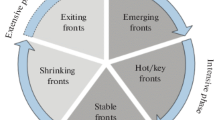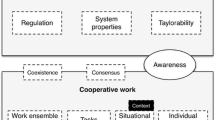Abstract
959 full text articles has been studied to explore the intellectual structure of scientometrics in the period 2005–2010 using text mining and co-word analysis. The trends and patterns of scientometrics in the journal Scientometrics were revealed by measuring the association strength of selected keywords which represent the produced concept and idea in the field of scientometrics. All articles were collected from the journal Scientometrics through Springerlink (full text database) and keywords were added non-parametrically from the LISA database and the articles themselves (keywords provided by author). Other important keywords are extracted from the title and abstract of the article manually. These keywords are standardized using a vocabulary tool. With the objective of delineating dynamic changes of the field of scientometrics, the period 2005–2010 was studied and further divided into two consecutive periods: 2005–2007 and 2008–2010. The results show that publication has some well-established topics which are changing gradually to adopt new themes.



















Similar content being viewed by others
References
An, X. Y., & Wu, Q. Q. (2011). Co-word analysis of the trends in stem cells field based on subject heading weighting. Scientometrics, 88(1), 133–144.
Bhattacharya, S., & Basu, R. K. (1998). Mapping a research area at the micro level using co-word analysis. Scientometrics, 43(3), 359–372.
Borner, K., Chen, C., & Boyack, K. W. (2003). Visualizing knowledge domains. Annual Review of Information Science and Technology, 37(1), 179–255.
Callon, M., Courtial, J. P., & Laville, F. (1991). Co-word analysis as a tool for describing the network of interactions between basic and technological research: the case of polymer chemistry. Scientometrics, 22(1), 153–203.
Cambrosio, A., Limoges, C., Courtial, J. P., & Laville, F. (1993). Historical scientometircs? Mapping over 70 years of biological safety research with co-word analysis. Scientometrics, 27(2), 119–143.
Coulter, N., Monarch, I., & Konda, S. (1998). Software engineering as seen through its research literature: A study in co-word analysis. Journal of the American Society for Information Science, 49(13), 1206–1223.
Courtial, J. P. (1994). A coword analysis of scientometrics. Scientometrics, 31(3), 251–260.
Courtial, J. P., Callon, M., & Sigogneau, A. (1993). The use of patent titles for identifying the topics of invention and forecasting trends. Scientometrics, 26(2), 231–242.
Culnan, M. J. (1986). The intellectual development of management information systems, 1972–1982: A co-citation analysis. Management Science, 32(2), 156–172.
Ding, Y., Chowdhury, G. G., & Foo, S. (2001). Bibliometric cartography of information retrieval research by using co-word analysis. Information Processing and Management, 37(6), 817–842.
He, Q. (1999). Knowledge discovery through co-word analysis. Library Trends, 48(1), 133–159.
Hinze, S. (1994). Bibliographical cartography of an emerging interdisciplinary discipline: The case of bioelectronics. Scientometrics, 29(3), 353–376.
Hou, H.Y., Liu, Z.Y., Chen, Y., Jiang, C.L., Yin, L.C., & Pang, J. (2006). Mapping of science studies: the trend of research fronts. Science Research Management, 22(3), 90–96.
Kopcsa, A., & Schiebel, E. (1998). Science and technology mapping: A new iteration model for representing multidimensional relationships. Journal of the American Society for Information Science, 49(1), 7–17.
Kostoff, R. N., Stump, J. A., Johnson, D., Murday, J. S., Lau, C. G. Y., & Tolles, W. M. (2006). The structure and infrastructure of the global nanotechnology literature. Journal of Nanoparticle Research, 8(3–4), 301–321.
Law, J., Bauin, S., Courtial, J.-P., & Whittaker, J. (1988). Policy and the mapping of scientific change: A co-word analysis of research into environmental acidification. Scientometrics, 14(3–4), 251–264.
Law, J., & Whittaker, J. (1992). Mapping acidification research: A test of the co-word method. Scientometrics, 23(3), 417–461.
Lee, B., & Jeong, Y. I. (2008). Mapping Korea’s national R&D domain of robot technology by using the co-word analysis. Scientometrics, 77(1), 3–19.
Leydesdorff, L., & Vaughan, L. (2006). Co-occurrence matrices and their applications in information science: Extending ACA to the web environment. Journal of the American Society for Information Science and Technology, 57(12), 1616–1628.
Leydesdorff, L., & Zaal, R. (1988). Co-words and citations. relations between document sets and environments. In L. Egghe, & R. Rousseau (Eds.), Informetrics 87/88 (pp. 105–19). Amsterdam: Elsevier.
Looze, M. D., & Lemarie, J. (1997). Corpus relevance through co-word analysis: An application to plant proteins. Scientometrics, 39(3), 267–280.
Mihalcea, R., Tarau, P. (2004). TextRank: Bringing order into texts. In Proceedings of the conference on empirical methods in natural language processing (EMNLP 2004). Barcelona: Spain.
Mohammadi, E. (2012). Knowledge mapping of the Iranian nanoscience and technology: A text mining approach. Scientometrics, 92(3), 593–608.
Mooghali, R., Alijani, M. S., Karami, N., & Khasseh, A. (2011). Scientometrics analysis of scientometrics literature. International Journal of Information Science and Management, 9(1), 19–31.
Musgrove, P. B., Binns, R., Page-Kennedy, T., & Thelwall, M. (2003). A method for identifying clusters in sets of interlinking web spaces. Scientometrics, 58(3), 657–672.
Noyons, C. (2005). Science maps within a science policy context. In Handbook of quantitative science and technology research, (pp. 237–255).
Noyons, E. C. M., & van Raan, A. F. J. (1994). Bibliometric cartography of scientific and technological development of an R&D field. Scientometrics, 30(1), 157–173.
Noyons, E. C. M., & van Raan, A. F. J. (1998). Monitoring scientific developments from a dynamic perspective: Self-organized structuring to map neural network research. Journal of the American Society for Information Science, 49(1), 68–81.
Polanco, X., Francois, C., & Keim, J. P. (1998). Artificial neural network technology for the classification and cartography of science and technology information. Scientometrics, 41(1–2), 69–82.
Ponzi, L. J. (2002). The intellectual structure and interdisciplinary breadth of knowledge management: A bibliometric study of its early stage of development. Scientometrics, 55(2), 259–272.
R Core Team (2012). R: A language and environment for statistical computing. R Foundation for Statistical Computing, Vienna, Austria. http://www.R-project.org/. Accessed 4 Sept 2013.
Rikken, P., Kiers, H. A. L., & Vos, R. (1995). Mapping the dynamics of adverse drug reactions in subsequent time periods using INDSCAL. Scientometrics, 33(3), 367–380.
Rip, A., & Courtial, J. P. (1984). Co-word maps of biotechnology: An example of cognitive scientometrics. Scientometrics., 6(6), 381–400.
Sedighi, M., & Jalalimanesh, A. (2014). Mapping research trends in the field of knowledge management. Malaysian Journal of Library and Information Science, 19(1), 71–85.
Small, H. (1973). Co-citation in the scientific literature: A new measure of the relationship between documents. Journal of the American Society for Information Science, 24(4), 265–269.
Small, H., & Griffith, B. (1974). The structure of scientific literature I: Identifying and graphing specialities. Science Studies, 4(1), 17–40.
Van Raan, A. F. J., & Tijssen, R. J. W. (1993). The neural net of neural network research. Scientometrics, 26(1), 169–192.
Wagner, C. S., & Leydesdorff, L. (2005). Network structure, self-organization, and the growth of international collaboration in science. Research Policy, 34(10), 1608–1618.
Yue, H. (2012). Mapping the intellectual structure by co-word: A case of international management science. Web Information Systems and Mining, 75(29), 621–628.
Acknowledgments
We are grateful to Dr. Ying Ding (Associate professor, Department of information science, Indiana University, Netherlands) for her valuable suggestion.
Author information
Authors and Affiliations
Corresponding author
Appendices
Appendix 1
Appendix 2: Status of keywords’ frequency during year 2005–2007 and 2008–2010
Rights and permissions
About this article
Cite this article
Ravikumar, S., Agrahari, A. & Singh, S.N. Mapping the intellectual structure of scientometrics: a co-word analysis of the journal Scientometrics (2005–2010). Scientometrics 102, 929–955 (2015). https://doi.org/10.1007/s11192-014-1402-8
Received:
Published:
Issue Date:
DOI: https://doi.org/10.1007/s11192-014-1402-8




